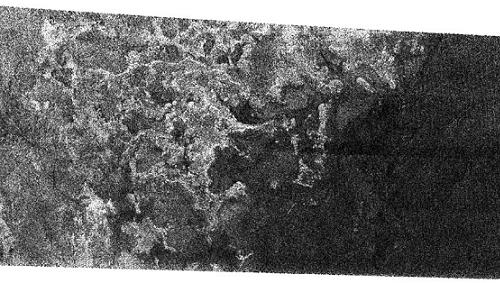An image released by NASA two days ago clearly showed a dark sea in front of light land in a Cassini radar scan
19.9.2005
By: Avi Blizovsky

The idea of a sea on the Saturnian moon Titan has not been ruled out even though no evidence of it was found in previous Cassini passes, nor in the successful Huygens landing.
A new image recently arrived from Cassini has scientists thinking it shows coastlines with bays and channels feeding fluid into a possible sea.
Scientists have long believed that there might be an ocean made of liquid methane or other hydrocarbons. Titan's chemistry is similar to that of early Earth, but Titan has no water. However, at the beginning of September 2005, another group of researchers estimated that life might exist on Titan today.
The radar data that showed these beaches (which in the light seem impossible to observe due to the clouds and smog) are the strongest evidence for the existence of a coastline." said Steve Wall, deputy director of the radar group at NASA's Jet Propulsion Laboratory in California.
The photo, published last Friday, showed a clear division between a bright and rocky area and a dark and smooth area - apparently a sea.
"It's a wet area covered in liquid today or in the recent past." Wall said. "Apparently there is random rain or a massive bubbling of liquid from the ground."
"We also see a network of channels moving along the bright area, and this indicates that fluids, most likely liquid hydrocarbons, flowed in this area." said Dr. Ellen Stephan, a member of the Cassini radar team and working at the Liatosville Research Center in Maryland.
Combining this image with images from previous transits of Titan allows scientists to identify two types of regions where fluid activity is evident. One type is of deep, arranged channels, where liquid probably flowed for a long time and over long distances. The second type are shorter channels created in short bursts of rain.
"It looks like fluids flowed through these channels and they connected deep within the ice that makes up the ground on Titan." said Larry Soderblum of the US Geological Survey in Flagstaff, Arizona. "Some of these channels stretch for 100 kilometers. Some of them are fed by springs while the others contain more complex networks that were probably filled with rainwater.
